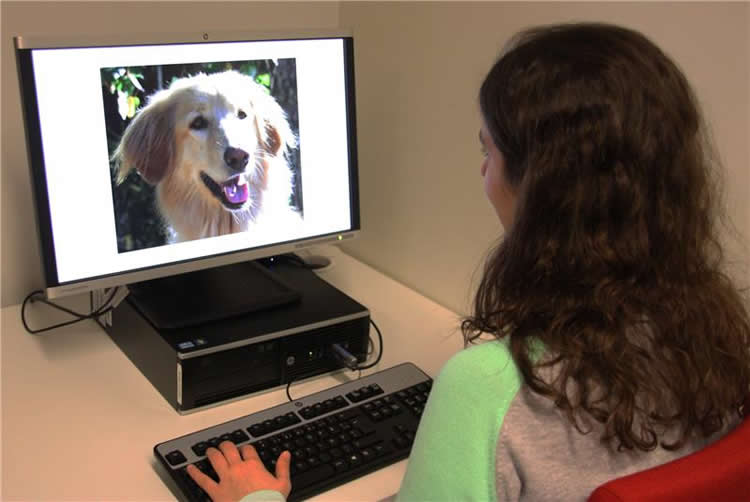Summary: A new study reveals empathy affects perceptions of a dog’s facial expressions.
Source: University of Helsinki.
Human empathy can even extend to dogs: empathetic people interpret dogs’ facial expressions more intensely.
A study by the University of Helsinki and Aalto University explored how empathy and other psychological factors affect people’s assessments of the facial images of dogs and humans.
The results show for the first time that human empathy, or the ability to share someone else’s feelings or experiences, also affects perceptions of the facial expressions of pet dogs.
“Empathy affected assessments of dogs’ facial expressions even more than previous experience of dogs, probably because the face is a biologically important stimulus for humans. Our earlier studies have showed, however, that when considering the entire body language of dogs, previous experience of dogs increases in importance,” explains postdoctoral researcher Miiamaaria Kujala.
Based on previous results, the researchers knew that people with higher emotional empathy evaluated other people’s expressions more quickly, accurately and often also more intensely.
However, Kujala notes that it is possible that they over-interpret the expressions of dogs.
“Empathy speeds up and intensifies the assessment of dogs’ facial expressions, but defining the accuracy of such assessments is currently unreliable.”
A threat is easier to perceive than happiness
Communication based on facial expressions has been studied in social mammals for decades. Darwin was already able to perceive similarities in mammals’ expressions, but it has taken until the present day for researchers to begin to understand similarities between the emotional expressions of different species.
The Animal Mind research group has previously demonstrated that dogs clearly recognise the threatening expressions of both humans and other dogs.
“They gazed intensively at threatening dogs, but quickly looked away from threatening humans. Also human subjects were good at recognising the threatening expressions of dogs and considered them much more intense than similar human expressions,” Kujala describes.
In contrast, people assessed happy faces more intensely in the case of humans than dogs. The researchers suggest that this may be due to the tendency to consider the faces of one’s own species generally more pleasant.

On the other hand, people may find it difficult to recognise happiness in dogs based on their facial expressions. This is indicated by the fact that people experienced in dog training estimated the happy expressions of dogs as happier than others did.
Produced collaboratively by the University of Helsinki’s Faculty of Veterinary Medicine and Faculty of Behavioural Sciences as well as Aalto University’s Department of Neuroscience and Biomedical Engineering, the study entitled Human Empathy, Personality and Experience Affect the Emotion Ratings of Dog and Human Facial Expressions has been published in the PLOS ONE journal.
The Animal Mind research group of the University of Helsinki’s Faculty of Veterinary Medicine collaborates with Aalto University and other partners in exploring phenomena related to the animal mind, such as cognition and emotions.
Source: Eero Kajantie – University of Helsinki
Image Source: NeuroscienceNews.com image is credited to Miiamaaria Kujala and Sanni Somppi.
Original Research: Full open access research for “Human Empathy, Personality and Experience Affect the Emotion Ratings of Dog and Human Facial Expressions” by Miiamaaria V. Kujala, Sanni Somppi, Markus Jokela, Outi Vainio, and Lauri Parkkonen in PLOS ONE. Published online January 23 2017 doi:10.1371/journal.pone.0170730
[cbtabs][cbtab title=”MLA”]University of Helsinki “Emapthetic People Experience Dogs’ Expressions More Strongly.” NeuroscienceNews. NeuroscienceNews, 4 February 2017.
<https://neurosciencenews.com/empathy-dog-expression-6057/>.[/cbtab][cbtab title=”APA”]University of Helsinki (2017, February 4). Emapthetic People Experience Dogs’ Expressions More Strongly. NeuroscienceNew. Retrieved February 4, 2017 from https://neurosciencenews.com/empathy-dog-expression-6057/[/cbtab][cbtab title=”Chicago”]University of Helsinki “Emapthetic People Experience Dogs’ Expressions More Strongly.” https://neurosciencenews.com/empathy-dog-expression-6057/ (accessed February 4, 2017).[/cbtab][/cbtabs]
Abstract
Human Empathy, Personality and Experience Affect the Emotion Ratings of Dog and Human Facial Expressions
Facial expressions are important for humans in communicating emotions to the conspecifics and enhancing interpersonal understanding. Many muscles producing facial expressions in humans are also found in domestic dogs, but little is known about how humans perceive dog facial expressions, and which psychological factors influence people’s perceptions. Here, we asked 34 observers to rate the valence, arousal, and the six basic emotions (happiness, sadness, surprise, disgust, fear, and anger/aggressiveness) from images of human and dog faces with Pleasant, Neutral and Threatening expressions. We investigated how the subjects’ personality (the Big Five Inventory), empathy (Interpersonal Reactivity Index) and experience of dog behavior affect the ratings of dog and human faces. Ratings of both species followed similar general patterns: human subjects classified dog facial expressions from pleasant to threatening very similarly to human facial expressions. Subjects with higher emotional empathy evaluated Threatening faces of both species as more negative in valence and higher in anger/aggressiveness. More empathetic subjects also rated the happiness of Pleasant humans but not dogs higher, and they were quicker in their valence judgments of Pleasant human, Threatening human and Threatening dog faces. Experience with dogs correlated positively with ratings of Pleasant and Neutral dog faces. Personality also had a minor effect on the ratings of Pleasant and Neutral faces in both species. The results imply that humans perceive human and dog facial expression in a similar manner, and the perception of both species is influenced by psychological factors of the evaluators. Especially empathy affects both the speed and intensity of rating dogs’ emotional facial expressions.
“Human Empathy, Personality and Experience Affect the Emotion Ratings of Dog and Human Facial Expressions” by Miiamaaria V. Kujala, Sanni Somppi, Markus Jokela, Outi Vainio, and Lauri Parkkonen in PLOS ONE. Published online January 23 2017 doi:10.1371/journal.pone.0170730






